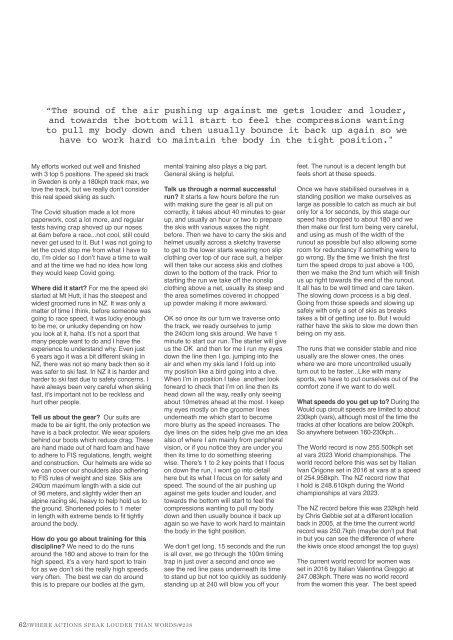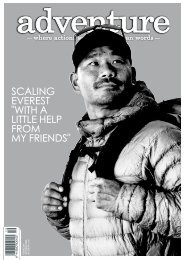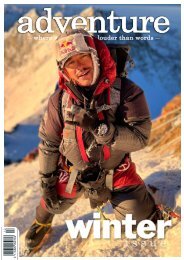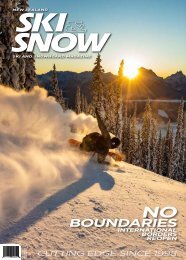You also want an ePaper? Increase the reach of your titles
YUMPU automatically turns print PDFs into web optimized ePapers that Google loves.
“The sound of the air pushing up against me gets louder and louder,<br />
and towards the bottom will start to feel the compressions wanting<br />
to pull my body down and then usually bounce it back up again so we<br />
have to work hard to maintain the body in the tight position."<br />
My efforts worked out well and finished<br />
with 3 top 5 positions. The speed ski track<br />
in Sweden is only a 180kph track max, we<br />
love the track, but we really don’t consider<br />
this real speed skiing as such.<br />
The Covid situation made a lot more<br />
paperwork, cost a lot more, and regular<br />
tests having crap shoved up our noses<br />
at 6am before a race...not cool, still could<br />
never get used to it. But I was not going to<br />
let the covid stop me from what I have to<br />
do, I’m older so I don’t have a time to wait<br />
and at the time we had no idea how long<br />
they would keep Covid going.<br />
Where did it start? For me the speed ski<br />
started at Mt Hutt, it has the steepest and<br />
widest groomed runs in NZ. It was only a<br />
matter of time I think, before someone was<br />
going to race speed, it was lucky enough<br />
to be me, or unlucky depending on how<br />
you look at it, haha. It’s not a sport that<br />
many people want to do and I have the<br />
experience to understand why. Even just<br />
6 years ago it was a bit different skiing in<br />
NZ, there was not so many back then so it<br />
was safer to ski fast. In NZ it is harder and<br />
harder to ski fast due to safety concerns. I<br />
have always been very careful when skiing<br />
fast, it's important not to be reckless and<br />
hurt other people.<br />
Tell us about the gear? Our suits are<br />
made to be air tight, the only protection we<br />
have is a back protector. We wear spoilers<br />
behind our boots which reduce drag. These<br />
are hand made out of hard foam and have<br />
to adhere to FIS regulations, length, weight<br />
and construction. Our helmets are wide so<br />
we can cover our shoulders also adhering<br />
to FIS rules of weight and size. Skis are<br />
240cm maximum length with a side cut<br />
of 96 meters, and slightly wider then an<br />
alpine racing ski, heavy to help hold us to<br />
the ground. Shortened poles to 1 meter<br />
in length with extreme bends to fit tightly<br />
around the body.<br />
How do you go about training for this<br />
discipline? We need to do the runs<br />
around the 180 and above to train for the<br />
high speed, it’s a very hard sport to train<br />
for as we don’t ski the really high speeds<br />
very often. The best we can do around<br />
this is to prepare our bodies at the gym,<br />
mental training also plays a big part.<br />
General skiing is helpful.<br />
Talk us through a normal successful<br />
run? It starts a few hours before the run<br />
with making sure the gear is all put on<br />
correctly, it takes about 40 minutes to gear<br />
up, and usually an hour or two to prepare<br />
the skis with various waxes the night<br />
before. Then we have to carry the skis and<br />
helmet usually across a sketchy traverse<br />
to get to the lower starts wearing non slip<br />
clothing over top of our race suit, a helper<br />
will then take our access skis and clothes<br />
down to the bottom of the track. Prior to<br />
starting the run we take off the nonslip<br />
clothing above a net, usually its steep and<br />
the area sometimes covered in chopped<br />
up powder making it more awkward.<br />
OK so once its our turn we traverse onto<br />
the track, we ready ourselves to jump<br />
the 240cm long skis around. We have 1<br />
minute to start our run. The starter will give<br />
us the OK and then for me I run my eyes<br />
down the line then I go, jumping into the<br />
air and when my skis land I fold up into<br />
my position like a bird going into a dive.<br />
When I’m in position I take another look<br />
forward to check that I’m on line then its<br />
head down all the way, really only seeing<br />
about 10metres ahead at the most. I keep<br />
my eyes mostly on the groomer lines<br />
underneath me which start to become<br />
more blurry as the speed increases. The<br />
dye lines on the sides help give me an idea<br />
also of where I am mainly from peripheral<br />
vision, or if you notice they are under you<br />
then its time to do something steering<br />
wise. There's 1 to 2 key points that I focus<br />
on down the run, I wont go into detail<br />
here but its what I focus on for safety and<br />
speed. The sound of the air pushing up<br />
against me gets louder and louder, and<br />
towards the bottom will start to feel the<br />
compressions wanting to pull my body<br />
down and then usually bounce it back up<br />
again so we have to work hard to maintain<br />
the body in the tight position.<br />
We don’t get long, 15 seconds and the run<br />
is all over, we go through the 100m timing<br />
trap in just over a second and once we<br />
see the red line pass underneath its time<br />
to stand up but not too quickly as suddenly<br />
standing up at 240 will blow you off your<br />
feet. The runout is a decent length but<br />
feels short at these speeds.<br />
Once we have stabilised ourselves in a<br />
standing position we make ourselves as<br />
large as possible to catch as much air but<br />
only for a for seconds, by this stage our<br />
speed has dropped to about 180 and we<br />
then make our first turn being very careful,<br />
and using as mush of the width of the<br />
runout as possible but also allowing some<br />
room for redundancy if something were to<br />
go wrong. By the time we finish the first<br />
turn the speed drops to just above a 100,<br />
then we make the 2nd turn which will finish<br />
us up right towards the end of the runout.<br />
It all has to be well timed and care taken.<br />
The slowing down process is a big deal.<br />
Going from those speeds and slowing up<br />
safely with only a set of skis as breaks<br />
takes a bit of getting use to. But I would<br />
rather have the skis to slow me down then<br />
being on my ass.<br />
The runs that we consider stable and nice<br />
usually are the slower ones, the ones<br />
where we are more uncontrolled usually<br />
turn out to be faster...Like with many<br />
sports, we have to put ourselves out of the<br />
comfort zone if we want to do well.<br />
What speeds do you get up to? During the<br />
Would cup circuit speeds are limited to about<br />
230kph (vars), although most of the time the<br />
tracks at other locations are below 200kph.<br />
So anywhere between 160-230kph...<br />
The World record is now 255.500kph set<br />
at vars 2023 World championships. The<br />
world record before this was set by Italian<br />
Ivan Origone set in 2016 at vars at a speed<br />
of 254.958kph. The NZ record now that<br />
I hold is 248.610kph during the World<br />
championships at vars 2023.<br />
The NZ record before this was 232kph held<br />
by Chris Gebbie set at a different location<br />
back in 2005, at the time the current world<br />
record was 250.7kph (maybe don’t put that<br />
in but you can see the difference of where<br />
the kiwis once stood amongst the top guys)<br />
The current world record for women was<br />
set in 2016 by Italian Valentina Greggio at<br />
247.083kph. There was no world record<br />
from the women this year. The best speed<br />
62//WHERE ACTIONS SPEAK LOUDER THAN WORDS/<strong>#238</strong>
















